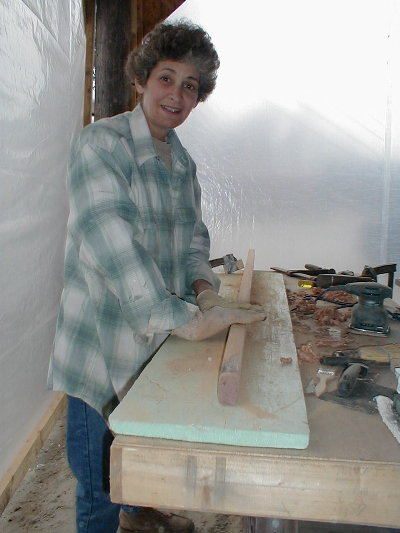Restoration
January 19, 2001
It looks like Brigadoon out at the Cherokeesite, as the restoration facility looms in and out of the ocean fog. The weather has been mercifully mild this week, but wet, wet, wet. Overall, it’s proving to be a very cold winter, which has fishermen worried about the upcoming shrimp season. Freezing temperatures lead to few shrimp (bad) and few mosquitoes (good) come summer. But no matter what the weather brings, the Huckins crew rolls right along come rain, sleet, fog, or wind.

The Boat Facility in the Fog
Bill Davis has been busy in the engine room, cleaning up the floor framing and prepping the area for engine placement. Meanwhile, “Wild Bill” Brown continues with his propulsion engineering. Two rough openings have been cut in the bottom and transom for the water jets. One of the crew was busy constructing a plywood mockup so that the water jets can be placed precisely where they need to be.


Meditation Time? No, Upside Down Picture of Bill Davis!
Jeanette continues the tedious task of stripping and sanding the toe rails. The layer of chalking on each section is so strong yet gummy she couldn’t remove it with sandpaper. She finally settled on the use of
an old fashioned planer, and the challenge is now conquerable. “Wouldn’t it be easier to just build new toe rails?” asked an innocent bystander with a camera. “We’re trying to maintain the character of the original boat as much as possible,” she explained. “And these are perfectly good toe rails. I think this whole project is going to be incredible.”
Jeanette, Happy to Restore Toe Rails
Jeanette also found a nice surprise from the past when removing a piece of shoe mold. Glued beneath the mold was a 1958 class “d” penny. Whether placed there for fun or function is anybody’s guess.

Buried Treasure
Tom and Leonard are deep in the process of splicing the keelson in the stateroom. A keelson is an internal keel in the form of a stringer. It’s bolted on to the keel to provide additional strength and to support the floors. The crew is preparing the stateroom to accept an extension of the keelson through the engine room to the transom. Cherokee is shaping up to be one sturdy vessel.

Leonard Working on Keelson

Leonard, Bryan, and Tom with Keelson

A Casey Sighting
At the latest Legislative Commission for Seafood and Aquaculture meeting, startling facts were presented about North Carolina’s blue crab industry. North Carolina is the number one producer of crabmeat in the U.S., producing more than Virginia and Maryland combined. Yet the number of processing plants has decreased by fifty percent in the couple of years. This is not because of any scarcity of crabs or labor – it’s because of imported crabmeat. “We pay our pickers 1.80 to 2.00 per pound,” explained processor (and Marine Fisheries Commission Chair) Jimmy Johnson, whose Beaufort County plant will not open this year. “In China, pickers are paid seven cents a pound. The market is getting flooded with this cheap product and we cannot compete with that.” Just five years ago the ratio of domestic to imported crabmeat was 70/30. Now those numbers are flipped, and a full 70 percent of crabmeat sold in the U.S. comes from countries like China, Indonesia, or Mexico. What can be done? Not much, short of educating the consumer that the higher prices for domestic meat is worth it, considering freshness, lack of preservatives, and the fact that, to paraphrase Sir Walter Scott, “it’s not crabs ye’re buyin’, it’s men’s lives!” Signing off for now, Barbara “Fish Doctor” Blake








